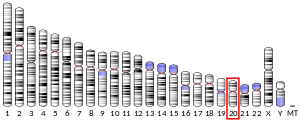RBBP9
Putative hydrolase RBBP9 is an enzyme that in humans is encoded by the RBBP9 gene.[5][6][7]
| RBBP9 | |||||||||||||||||||||||||
|---|---|---|---|---|---|---|---|---|---|---|---|---|---|---|---|---|---|---|---|---|---|---|---|---|---|
| |||||||||||||||||||||||||
| Identifiers | |||||||||||||||||||||||||
| Aliases | RBBP9, BOG, RBBP10, retinoblastoma binding protein 9, RB binding protein 9, serine hydrolase | ||||||||||||||||||||||||
| External IDs | OMIM: 602908 MGI: 1347074 HomoloGene: 4816 GeneCards: RBBP9 | ||||||||||||||||||||||||
| |||||||||||||||||||||||||
| |||||||||||||||||||||||||
| |||||||||||||||||||||||||
| Orthologs | |||||||||||||||||||||||||
| Species | Human | Mouse | |||||||||||||||||||||||
| Entrez | |||||||||||||||||||||||||
| Ensembl | |||||||||||||||||||||||||
| UniProt | |||||||||||||||||||||||||
| RefSeq (mRNA) | |||||||||||||||||||||||||
| RefSeq (protein) | |||||||||||||||||||||||||
| Location (UCSC) | Chr 20: 18.49 – 18.5 Mb | Chr 2: 144.54 – 144.55 Mb | |||||||||||||||||||||||
| PubMed search | [3] | [4] | |||||||||||||||||||||||
| Wikidata | |||||||||||||||||||||||||
| |||||||||||||||||||||||||
Function
The protein encoded by this gene is a retinoblastoma binding protein that may play a role in the regulation of cell proliferation and differentiation. Two alternatively spliced transcript variants of this gene with identical predicted protein products have been reported, one of which is a nonsense-mediated decay candidate.[7]
Interactions
RBBP9 has been shown to interact with Retinoblastoma protein.[5]
gollark: OR DOES IT?
gollark: Alternatively, use a system of mirrors to point the screen of each computer at the webcam of another.
gollark: I think the best strategy would be to use SD card slots for inter-computer communication.
gollark: SolarFlame: analog bad.
gollark: You could work out a worst-case scenario by calculating how much energy is needed to raise all the blood in a human to 100 degrees, then dividing that by the microwave's power output.
References
- GRCh38: Ensembl release 89: ENSG00000089050 - Ensembl, May 2017
- GRCm38: Ensembl release 89: ENSMUSG00000027428 - Ensembl, May 2017
- "Human PubMed Reference:". National Center for Biotechnology Information, U.S. National Library of Medicine.
- "Mouse PubMed Reference:". National Center for Biotechnology Information, U.S. National Library of Medicine.
- Woitach JT, Zhang M, Niu CH, Thorgeirsson SS (Aug 1998). "A retinoblastoma-binding protein that affects cell-cycle control and confers transforming ability". Nature Genetics. 19 (4): 371–4. doi:10.1038/1258. PMID 9697699.
- Woitach JT, Hong R, Keck CL, Zimonjic DB, Popescu NC, Thorgeirsson SS (Oct 1999). "Assignment of the Bog gene (RBBP9) to syntenic regions of mouse chromosome 2G1-H1 and human chromosome 20p11.2 by fluorescence in situ hybridization". Cytogenetics and Cell Genetics. 85 (3–4): 252–3. doi:10.1159/000015304. PMID 10449909.
- "Entrez Gene: RBBP9 retinoblastoma binding protein 9".
Further reading
- Chen JZ, Yang QS, Wang S, Meng XF, Ying K, Xie Y, Ma YM (Aug 2002). "Cloning and expression of a novel retinoblastoma binding protein cDNA, RBBP10". Biochemical Genetics. 40 (7–8): 273–82. doi:10.1023/A:1019886918029. PMID 12296629.
- Chen J, Ji C, Gu S, Zhao E, Dai J, Huang L, Qian J, Ying K, Xie Y, Mao Y (2003). "Isolation and identification of a novel cDNA that encodes human yrdC protein". Journal of Human Genetics. 48 (4): 164–9. doi:10.1007/s10038-002-0001-3. PMID 12730717.
- Rual JF, Venkatesan K, Hao T, Hirozane-Kishikawa T, Dricot A, Li N, Berriz GF, Gibbons FD, Dreze M, Ayivi-Guedehoussou N, Klitgord N, Simon C, Boxem M, Milstein S, Rosenberg J, Goldberg DS, Zhang LV, Wong SL, Franklin G, Li S, Albala JS, Lim J, Fraughton C, Llamosas E, Cevik S, Bex C, Lamesch P, Sikorski RS, Vandenhaute J, Zoghbi HY, Smolyar A, Bosak S, Sequerra R, Doucette-Stamm L, Cusick ME, Hill DE, Roth FP, Vidal M (Oct 2005). "Towards a proteome-scale map of the human protein-protein interaction network". Nature. 437 (7062): 1173–8. doi:10.1038/nature04209. PMID 16189514.
This article is issued from Wikipedia. The text is licensed under Creative Commons - Attribution - Sharealike. Additional terms may apply for the media files.



